| back to: Chapter 9
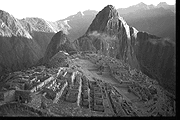
Machu Picchu
Urumba Valley, Peru
architecture
1490-1530 (Incan)

Gateway Arch (St. Louis)
Eero Saarinen
architecture
1966 (Modern)
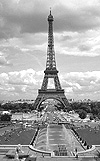
Eiffel Tower (Paris)
Gustave Eiffel
architecture
1889 (Modern)

Wainwright Building (St. Louis)
Louis Sullivan
architecture
1890 (Modern)
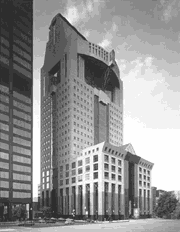
Humana Building (Louisville)
Michael Graves
architecture
1986 (Postmodern)
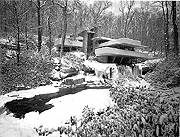
Fallingwater (Bear Run, PA)
Frank Lloyd Wright
architecture
1936 (Modern)
|
Chapter 10: Architecture
Stone Architecture
- POST-AND-LINTEL CONSTRUCTION
is an architectural construction method that relies on the effect of gravity and spanning a short distance between two upright supports. It is one of the oldest methods of construction and Stonehenge uses this type of construction method as does the city of Machu Picchu in Peru. Of course, Greek temples like the Parthenon also used this method.
- ARCHES
are an architectural innovation that we usually associate with the ancient Roman civilization. Arches are still used to create great spans as in the Gateway Arch in St. Louis.
- VAULTS
are arches that have been extended into long open spaces. Barrel vaults create round curved ceilings and are central to the construction of Romanesque churches, whereas Gothic churches used pointed arches and Groin vaults in their construction. An excellent example of a building that used pointed arch construction is Amiens Cathedral in France.
- DOMES
are hemispherically-shaped forms that are derived from the arch. One of the great domed buildings in the ancient world was the Pantheon in Rome. We can see how enormous the interior is in this photograph.
Wood Architecture
- POST AND BEAM CONSTRUCTION
excellent examples of post and beam wood construction can be found in Japan. For example, the Nijo-Castle in Kyoto is an example of a wood and beam construction.
- TRUSSES
are legths of wood which are used in lieu of beams. Often they are used in architecture like that of the Nijo-Castle.
- BALLOON FRAMING
is used in most post-WWII housing construction.
Cast Iron Architecture
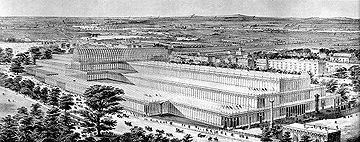
Crystal Palace * London, England * Modern architecture * 1851 * by Joseph Paxton
Here's a drawing of the original "Palace" on location at the 1851 World's Fair to give you a sense of its size.
Cast Iron architecture was created for versatility and structural character. The Eiffel Tower is an excellent example of cast iron architecture.
Steel Cage Architecture
- First used in the latter half of the 19th Century, this type of construction method led to the creation of the modern skyscraper and redesigned our urban environment. The Wainwright Building in St. Louis is one of the oldest steel cage skyscrapers still in existence. Stylistic change occurred in the early 20th Century with minmalist Modern architecture like that of Ludwig Mies Van Der Rohe who coined the phrase "less is more." By the late 20th Century architectural styles changed from a purist and minmalist attiude to an eclectic one. Postmodernist architects like Michael Graves began merging architectural methods and styles from the past to create a new style of architecture.
Reinforced Concrete Architecture
- Le Corbusier's Notre Dame du Haute at Ronchamp is an excellent example of what can be done with reinforced concrete. Le Corbusier shows a great deal of freedom in shaping this building. Frank Lloyd Wright also uses the attributes of reinforced concrete to his advantage in Fallingwater, a house that is located on a stream in Bear Run, Pennsylvania.
Steel Cable Architecture
- most examples of this occur in bridge architecture like the Brooklyn and Golden Gate Bridges.
Shell Architecture
- is common because it is useful and inexpensive. These structures are usually lightweight and less permanent than other traditional methods.
More on Postmodern Architecture
- Postmodern architectural ideas were articualted by Robert Venutri in his books Learning from Las Vegas and Complexity and Contradiction in Architecture. In these two texts Venturi speaks about the needs of community in a world dominated by automobiles. Architecture, to Venturi, needs to promote its interior function by expressing it in its exterior form.
Venturi House
Frank Gehry exemplified Postmodern contradiction with his the architectural design of his own house in Santa Monica or the Guggenheim Museum in Bilbao, Spain.
An architect who influenced Postmodern style is Antonio Gaudi. His Casa Battlo is often categorized as Expressionistic architecture.
Other Postmodern styles include High Tech and Vernacular architectural types. Vernacular architecture is taken from specific geographic historical contexts.
Seaside Florida Homes by Andres Duany and Elizabeth Plater-Zyberk.
Chapter 11
| |
|
